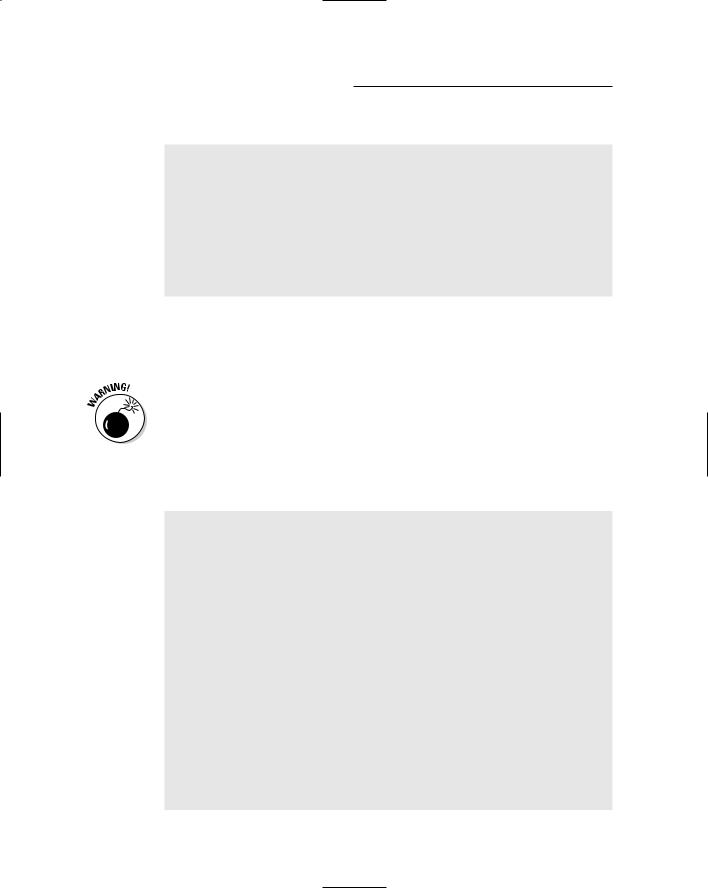
- •Table of Contents
- •Introduction
- •What Is C++?
- •Conventions Used in This Book
- •How This Book Is Organized
- •Part I: Introduction to C++ Programming
- •Part III: Introduction to Classes
- •Part IV: Inheritance
- •Part V: Optional Features
- •Part VI: The Part of Tens
- •Icons Used in This Book
- •Where to Go from Here
- •Grasping C++ Concepts
- •How do I program?
- •Installing Dev-C++
- •Setting the options
- •Creating Your First C++ Program
- •Entering the C++ code
- •Building your program
- •Executing Your Program
- •Dev-C++ is not Windows
- •Dev-C++ help
- •Reviewing the Annotated Program
- •Examining the framework for all C++ programs
- •Clarifying source code with comments
- •Basing programs on C++ statements
- •Writing declarations
- •Generating output
- •Calculating Expressions
- •Storing the results of expression
- •Declaring Variables
- •Declaring Different Types of Variables
- •Reviewing the limitations of integers in C++
- •Solving the truncation problem
- •Looking at the limits of floating-point numbers
- •Declaring Variable Types
- •Types of constants
- •Special characters
- •Are These Calculations Really Logical?
- •Mixed Mode Expressions
- •Performing Simple Binary Arithmetic
- •Decomposing Expressions
- •Determining the Order of Operations
- •Performing Unary Operations
- •Using Assignment Operators
- •Why Mess with Logical Operations?
- •Using the Simple Logical Operators
- •Storing logical values
- •Using logical int variables
- •Be careful performing logical operations on floating-point variables
- •Expressing Binary Numbers
- •The decimal number system
- •Other number systems
- •The binary number system
- •Performing Bitwise Logical Operations
- •The single bit operators
- •Using the bitwise operators
- •A simple test
- •Do something logical with logical calculations
- •Controlling Program Flow with the Branch Commands
- •Executing Loops in a Program
- •Looping while a condition is true
- •Using the for loop
- •Avoiding the dreaded infinite loop
- •Applying special loop controls
- •Nesting Control Commands
- •Switching to a Different Subject?
- •Writing and Using a Function
- •Divide and conquer
- •Understanding the Details of Functions
- •Understanding simple functions
- •Understanding functions with arguments
- •Overloading Function Names
- •Defining Function Prototypes
- •Variable Storage Types
- •Including Include Files
- •Considering the Need for Arrays
- •Using an array
- •Initializing an array
- •Accessing too far into an array
- •Using arrays
- •Defining and using arrays of arrays
- •Using Arrays of Characters
- •Creating an array of characters
- •Creating a string of characters
- •Manipulating Strings with Character
- •String-ing Along Variables
- •Variable Size
- •Address Operators
- •Using Pointer Variables
- •Comparing pointers and houses
- •Using different types of pointers
- •Passing Pointers to Functions
- •Passing by value
- •Passing pointer values
- •Passing by reference
- •Limiting scope
- •Examining the scope problem
- •Providing a solution using the heap
- •Defining Operations on Pointer Variables
- •Re-examining arrays in light of pointer variables
- •Applying operators to the address of an array
- •Expanding pointer operations to a string
- •Justifying pointer-based string manipulation
- •Applying operators to pointer types other than char
- •Contrasting a pointer with an array
- •Declaring and Using Arrays of Pointers
- •Utilizing arrays of character strings
- •Identifying Types of Errors
- •Choosing the WRITE Technique for the Problem
- •Catching bug #1
- •Catching bug #2
- •Calling for the Debugger
- •Defining the debugger
- •Finding commonalities among us
- •Running a test program
- •Single-stepping through a program
- •Abstracting Microwave Ovens
- •Preparing functional nachos
- •Preparing object-oriented nachos
- •Classifying Microwave Ovens
- •Why Classify?
- •Introducing the Class
- •The Format of a Class
- •Accessing the Members of a Class
- •Activating Our Objects
- •Simulating real-world objects
- •Why bother with member functions?
- •Adding a Member Function
- •Creating a member function
- •Naming class members
- •Calling a Member Function
- •Accessing a member function
- •Accessing other members from a member function
- •Defining a Member Function in the Class
- •Keeping a Member Function After Class
- •Overloading Member Functions
- •Defining Arrays of and Pointers to Simple Things
- •Declaring Arrays of Objects
- •Declaring Pointers to Objects
- •Dereferencing an object pointer
- •Pointing toward arrow pointers
- •Passing Objects to Functions
- •Calling a function with an object value
- •Calling a function with an object pointer
- •Calling a function by using the reference operator
- •Returning to the Heap
- •Comparing Pointers to References
- •Linking Up with Linked Lists
- •Performing other operations on a linked list
- •Hooking up with a LinkedListData program
- •A Ray of Hope: A List of Containers Linked to the C++ Library
- •Protecting Members
- •Why you need protected members
- •Discovering how protected members work
- •Protecting the internal state of the class
- •Using a class with a limited interface
- •Creating Objects
- •Using Constructors
- •Why you need constructors
- •Making constructors work
- •Dissecting a Destructor
- •Why you need the destructor
- •Working with destructors
- •Outfitting Constructors with Arguments
- •Justifying constructors
- •Using a constructor
- •Defaulting Default Constructors
- •Constructing Class Members
- •Constructing a complex data member
- •Constructing a constant data member
- •Constructing the Order of Construction
- •Local objects construct in order
- •Static objects construct only once
- •Global objects construct in no particular order
- •Members construct in the order in which they are declared
- •Destructors destruct in the reverse order of the constructors
- •Copying an Object
- •Why you need the copy constructor
- •Using the copy constructor
- •The Automatic Copy Constructor
- •Creating Shallow Copies versus Deep Copies
- •Avoiding temporaries, permanently
- •Defining a Static Member
- •Why you need static members
- •Using static members
- •Referencing static data members
- •Uses for static data members
- •Declaring Static Member Functions
- •What Is This About, Anyway?
- •Do I Need My Inheritance?
- •How Does a Class Inherit?
- •Using a subclass
- •Constructing a subclass
- •Destructing a subclass
- •Having a HAS_A Relationship
- •Why You Need Polymorphism
- •How Polymorphism Works
- •When Is a Virtual Function Not?
- •Considering Virtual Considerations
- •Factoring
- •Implementing Abstract Classes
- •Describing the abstract class concept
- •Making an honest class out of an abstract class
- •Passing abstract classes
- •Factoring C++ Source Code
- •Defining a namespace
- •Implementing Student
- •Implementing an application
- •Project file
- •Creating a project file under Dev-C++
- •Comparing Operators with Functions
- •Inserting a New Operator
- •Overloading the Assignment Operator
- •Protecting the Escape Hatch
- •How Stream I/O Works
- •The fstream Subclasses
- •Reading Directly from a Stream
- •Using the strstream Subclasses
- •Manipulating Manipulators
- •Justifying a New Error Mechanism?
- •Examining the Exception Mechanism
- •What Kinds of Things Can I Throw?
- •Adding Virtual Inheritance
- •Voicing a Contrary Opinion
- •Generalizing a Function into a Template
- •Template Classes
- •Do I Really Need Template Classes?
- •Tips for Using Templates
- •The string Container
- •The list Containers
- •Iterators
- •Using Maps
- •Enabling All Warnings and Error Messages
- •Insisting on Clean Compiles
- •Limiting the Visibility
- •Avoid Overloading Operators
- •Heap Handling
- •Using Exceptions to Handle Errors
- •Avoiding Multiple Inheritance
- •Customize Editor Settings to Your Taste
- •Highlight Matching Braces/Parentheses
- •Enable Exception Handling
- •Include Debugging Information (Sometimes)
- •Create a Project File
- •Customize the Help Menu
- •Reset Breakpoints after Editing the File
- •Avoid Illegal Filenames
- •Include #include Files in Your Project
- •Executing the Profiler
- •System Requirements
- •Using the CD with Microsoft Windows
- •Using the CD with Linux
- •Development tools
- •Program source code
- •Index

60 |
Part I: Introduction to C++ Programming |
cout << “Arg1 cout << “Arg2 cout << “~nArg1 cout << “~nArg2
=0x” << nArg1 << “\n”;
=0x” << nArg2 << “\n”;
=0x” << ~nArg1 << “\n”;
=0x” << ~nArg2 << “\n”;
// now the binary operators cout << “nArg1 & nArg2 = 0x”
<<(nArg1 & nArg2)
<<“\n”;
cout << “nArg1 | nArg2 = 0x”
<<(nArg1 | nArg2)
<<“\n”;
cout << “nArg1 ^ nArg2 = 0x”
<<(nArg1 ^ nArg2)
<<“\n”;
//wait until user is ready before terminating program
//to allow the user to see the program results system(“PAUSE”);
return 0;
}
The first expression in our program, cout.setf(ios::hex), sets the output format from the default decimal to hexadecimal (you’ll have to trust me for now that it works).
The remainder of the program is straightforward. The program assigns nArg1 the test value 0x1234 and nArg2 the value 0x00ff. The program then out puts all combinations of bitwise calculations. The process looks like this:
Arg1 |
= |
0x1234 |
Arg2 |
= |
0xff |
~nArg1 |
= |
0xffffedcb |
~nArg2 |
= |
0xffffff00 |
nArg1 & nArg2 = |
0x34 |
|
nArg1 | nArg2 = |
0x12ff |
|
nArg1 ^ nArg2 = |
0x12cb |
|
Press any key to continue . . .
Do something logical with logical calculations
Running through simple and bitwise logical calculations in your head at par ties is fun (well, okay, for some of us), but a program has to make actual, prac tical use of these values to make them worth the trouble. Coming right up:
Chapter 5 demonstrates how logical calculations are used to control program flow.

Chapter 5
Controlling Program Flow
In This Chapter
Controlling the flow through the program
Executing a group of statements repetitively
Avoiding infinite loops
The simple programs that appear in Chapters 1 through 4 process a fixed number of inputs, output the result of that calculation, and quit. However,
these programs lack any form of flow control. They cannot make tests of any sort. Computer programs are all about making decisions. If the user presses a key, the computer responds to the command.
For example, if the user presses Ctrl+C, the computer copies the currently selected area to the Clipboard. If the user moves the mouse, the pointer moves on the screen. If the user clicks the right mouse button with the Windows key depressed, the computer crashes. The list goes on and on. Programs that don’t make decisions are necessarily pretty boring.
Flow-control commands allow the program to decide what action to take, based on the results of the C++ logical operations performed (see Chapter 4). There are basically three types of flow-control statements: the branch, the loop, and the switch.
Controlling Program Flow with the Branch Commands
The simplest form of flow control is the branch statement. This instruction allows the program to decide which of two paths to take through C++ instruc tions, based on the results of a logical expression (see Chapter 4 for a descrip tion of logical expressions).

62 |
Part I: Introduction to C++ Programming |
In C++, the branch statement is implemented using the if statement:
if (m > n)
{
//Path 1
//...instructions to be executed if
//m is greater than n
}
else
{
//Path 2
//...instructions to be executed if not
}
First, the logical expression m > n is evaluated. If the result of the expression is true, control passes down the path marked Path 1 in the previous snip pet. If the expression is false, control passes to Path 2. The else clause is optional. If it is not present, C++ acts as if it is present but empty.
Actually, the braces are optional (sort of) if there’s only one statement to exe cute as part of the if. If you lose the braces, however, it’s embarrassingly easy to make a mistake that the C++ compiler can’t catch. The braces serve as a guide marker; it’s much safer to include ’em. (If your friends try to entice you into not using braces, “Just say No.”)
The following program demonstrates the if statement (note all the lovely braces):
//BranchDemo - input two numbers. Go down one path of the
//program if the first argument is greater than
//the first or the other path if not
#include <cstdio> #include <cstdlib> #include <iostream> using namespace std;
int main(int nNumberofArgs, char* pszArgs[])
{
//input the first argument...
int arg1;
cout << “Enter arg1: “; cin >> arg1;
//...and the second
int arg2;
cout << “Enter arg2: “; cin >> arg2;
// now decide what to do: if (arg1 > arg2)
